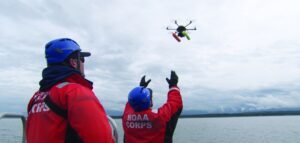
NOAA is predicting clear skies for a new drone program the agency rolls out this week.
In a media statement, the agency announced the launch of the Unmanned Systems Operations Program. “The new program will promote the safe, efficient and economical operation of unmanned systems NOAA uses to collect high-quality environmental data for the agency’s science, products and services.”
“Unmanned airborne and maritime systems are transforming how we conduct earth science at NOAA,” said retired Navy Rear Adm. Timothy Gallaudet, Ph.D., deputy NOAA administrator. “Our new Unmanned Systems Operations Program will help us dramatically increase the application and use of these technologies in every NOAA mission area.”
NOAA drones – dubbed UxS – are sensor-equipped and can operate autonomously or are remotely piloted. NOAA currently uses UxS for seafloor and habitat mapping, ocean exploration, marine mammal and fishery stock assessments, emergency response, and at-sea observations that improve forecasting of extreme events, such as harmful algal blooms and hypoxia.
“The recent increase in the availability of highly capable UxS has brought a corresponding increase in their innovative use as a force multiplier for many NOAA programs. NOAA’s use of small unmanned aircraft for science missions has increased more than tenfold since 2012.”
The Unmanned Systems Operations Program is being established within NOAA’s Office of Marine and Aviation Operations (OMAO), which operates, manages and maintains the agency’s fleet of ships and aircraft and oversees NOAA’s diving and small boat safety programs. Its services will include training, cybersecurity, acquisition and other expert support to ensure safe, cost-effective operations across the agency.
“With the creation of this new program, we will be better positioned to transition these technologies into operational platforms that will gather critical environmental data every American relies upon,” said Rear Adm. Michael J. Silah, director of the NOAA Commissioned Officer Corps and OMAO.
The new program will be housed at two locations. The NOAA Aircraft Operations Center in Lakeland, Fla., will continue to support the agency’s unmanned aircraft activities. A new facility being built by the Mississippi State Port Authority in partnership with the University of Southern Mississippi in Gulfport, Miss., will support unmanned maritime systems.
NOAA received $12.7 million from Congress this year to improve and expand UxS operations across the agency, including the creation of the new program — a key goal of NOAA’s recently released Unmanned Systems Strategy.
Last year, a NOAA research paper in Bulletin of the American Meteorological Society outlined how disposable could be used to gather data from a hurricane’s lower eyewall – the most dangerous part.
Jason is a longstanding contributor to DroneLife with an avid interest in all things tech. He focuses on anti-drone technologies and the public safety sector; police, fire, and search and rescue.
Beginning his career as a journalist in 1996, Jason has since written and edited thousands of engaging news articles, blog posts, press releases and online content.
Email Jason
TWITTER:@JasonPReagan
Subscribe to DroneLife here.







[…] autonomous drones are part of NOAA’s Unmanned Systems Operations Program launched in March. The Alaskan mini-fleet forms part of a three-prong effort to deploy research […]